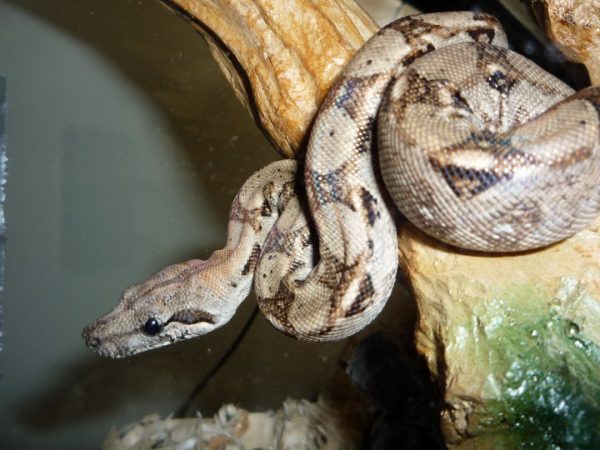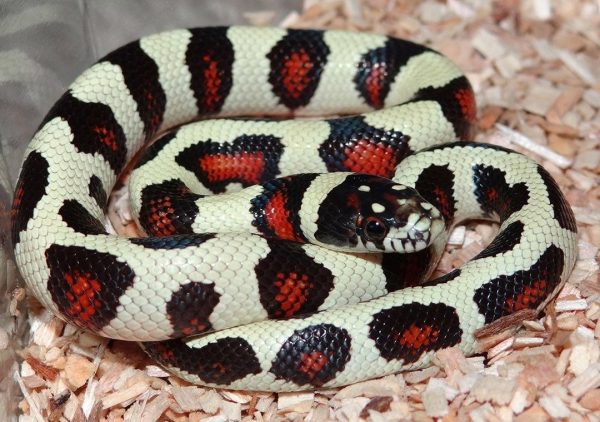Snakes Species:- Different species of snakes with different diet/environmental requirements can be found as pets; some are more suitable than others.
For beginners, small, gentle snakes having more easily managed diet/environmental needs are corn snakes, king snakes, or ball pythons.
Snakes requiring strict temperature and humidity requirements, water snakes, wild snakes, and venomous snakes aren’t recommended as pets.
Secure enclosures devoid of gaps are necessary as snakes are persistent in attempting to escape. Know how to find them.
Read About
- Top 50 Horse Breeds | Best Riding Horses
- Top 10 Cat Breeds (Cutest)
- Top 10 Cutest Dog Breeds | Most Adorable Dogs (2021)
- Top 10 Endangered Animal Species Across World
Top 15 Snakes Species
Boa

Boas belongs to the Boidae family, which comprises pythons and boas of various shapes and sizes.
Unlike other snakes, boas have two lungs, and they have rudimentary legs, which indicate their distant kinship to lizards.
These snakes kill prey by coiling around the victim and constricting it until it suffocates. These snakes can be terrestrial, arboreal, or burrowing. Boas are non-venomous.
Burmese Python

Burmese pythons belong to the group of the largest snakes on earth, and they reach 14 to 20 feet in length.
They are not venomous, so they kill their victims by constricting them. Pythons smell in a very peculiar manner.
They have the “Jacobson’s organ in the roof of the mouth” and its particles can get on the tongue. The snake darts forth its tongue and thus studies the surroundings.
Cateyed Snake

Cat-eyed Snakes have green bodies. They are calm, docile, and trainable; therefore, they make good pets.
These snakes are available on the market, and it is better to buy captive-born snakes. Cat-eyed Snakes are green and brown in color with shades of gray. The head is darker than the rest of the body, and the belly is somewhat lighter.
Cobra

Cobras are famous for their distinctive hood, which they spread when threatened or annoyed.
Their venomous glands produce very potent venom; therefore, their bite is deadly. Cobras can be found in South Asia, Africa, and the Philippines.
Statistics report many deaths from Cobra bites in India. However, they do not attack without provocation, but they do resort to their weapon when it comes to fighting.
Corn Snake

Corn Snakes occur in the United States and it is one of the most brightly colored ones. It features distinctive patterns of black-edged orange spots, and these patterns differ in accordance with age and habitat.
Corn Snakes are not venomous, and they kill prey by repeated biting and wrapping around the victim’s body until it suffocates. Corn Snakes are fine climbers, and this allows them to prey on birds.
Eastern Hognose Snake

The Eastern Hognose Snake is named for its distinctive upturned nose and flathead, and many people mistake it for a venomous snake.
It can be found in the drylands of Indiana. Eastern Hognose Snakes come in black, olive, brown, and so forth, and they feature patterns of irregular splotches and mottles.
If threatened, the snake lands preventive strokes on the enemy, using its head, and then plays dead.
Emerald Tree Boa

Emerald Tree Boas live in rainforests with marshy ground and substantial vegetation. They spend much time in trees and shrubs in the proximity of water.
The snake has a leaf-green color of the body and distinctive white stripes and splotches, which emulate patterns of sunrays spilling through leaves and thickets.
This nocturnal snake produces the young by internal gestation, and it has a life span of 15 years.
Gopher Snake

The Gopher Snake (Genus Pituophis) can be found in deserts and coniferous woods of the American Southwest. It can reach 96 inches in length.
Colors include cream-yellow, green-gray, and tan, and there are black, brown, and red blotches on the back.
Gophers hunt in crevices, furrows, and small hollows. If attacked, the snake produces a hissing sound. Gopher Snakes wrap around prey and kill it by constriction.
King Corn

King Corn Snakes reach about 3 feet in length. They are docile and trainable and well available on the market.
King Corns feature gorgeous copper-red or brown splotches against a light tan background, which are fringed in black.
Color combinations can be different. These snakes are great escapists; therefore, cages should be equipped with reliable locking mechanisms. King Corns require little maintenance, and they take to people soon after purchase.
King Snake

King Snakes can be found in North America. This non-venomous snake (Lamporeltis) kills by wrapping around and constricting prey to death.
It feeds on rodents, birds, and other snakes; in many aspects, it acts as a rodent controller.
King Snakes are 3-5 ft long (90-150 cm,) and they occur in dark brown or black, featuring distinctive patterns of white or yellow bands. Scarlet kingsnakes feature black, red, and yellow rings.
Mangrove Snake

There are 7 distinct types of Mangrove Snakes. All of them are common in the Malay Peninsula and neighboring Sumatra. Some species can also be found in Singapore.
This is a rather aggressive rear-fanged snake, but it is less dangerous than the highly venomous Krait.
It occurs in black with relatively narrow yellow bands all the way along the body. Mangrove snakes are very aggressive when it comes to feeding.
Milk Snake

Milk snakes can be found in many parts of the USA. They often approach houses and farms in search of small mammals.
Milk snakes are often misidentified as rattlesnakes because of the similar structure of the tail and the ability to produce characteristic noise.
Milk snakes feature reddish splotches with thin black linings against a tan or yellowish background. The belly is usually white. Milk snakes are about 25-30 inches in length.
Python

Pythons belong to the Boidae family, and there are about 25 species on the planet. All pythons are constrictors and none of them are venomous.
Females can lay as many as one hundred eggs. Pythons are docile and intelligent, and they can make good pets.
However, Reticulated Pythons are way too large to be kept in the house, and they can reach more than thirty feet in length.
Rat Snake

Rat Snakes belong to the genera of Elaphe, and they are large in size, reaching 8.5 feet in length.
There are five distinct species of Rat Snakes: Texas Rat Snake, Everglade Rat Snake, Black Rat Snake, Yellow Rat Snake, and Gray Rat Snake.
These species vary in habitat and in colors. They mostly feature blotched patterns with longitudinal stripes. Their large size allows them to hunt relatively big game.
Rattle Snake

Rattle Snakes are venomous New World snakes. They are named for a rattle at the tip of their tail, which is used for warning.
These snakes are carnivorous, feeding on rodents and other small animals. The Rattle Snake is common prey for hawks, eagles, and other birds of prey.